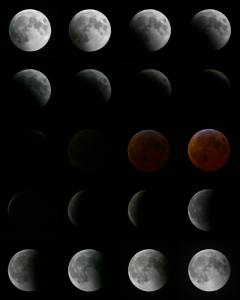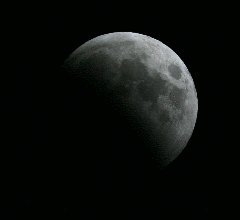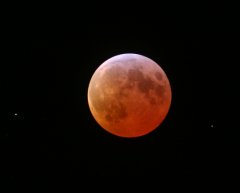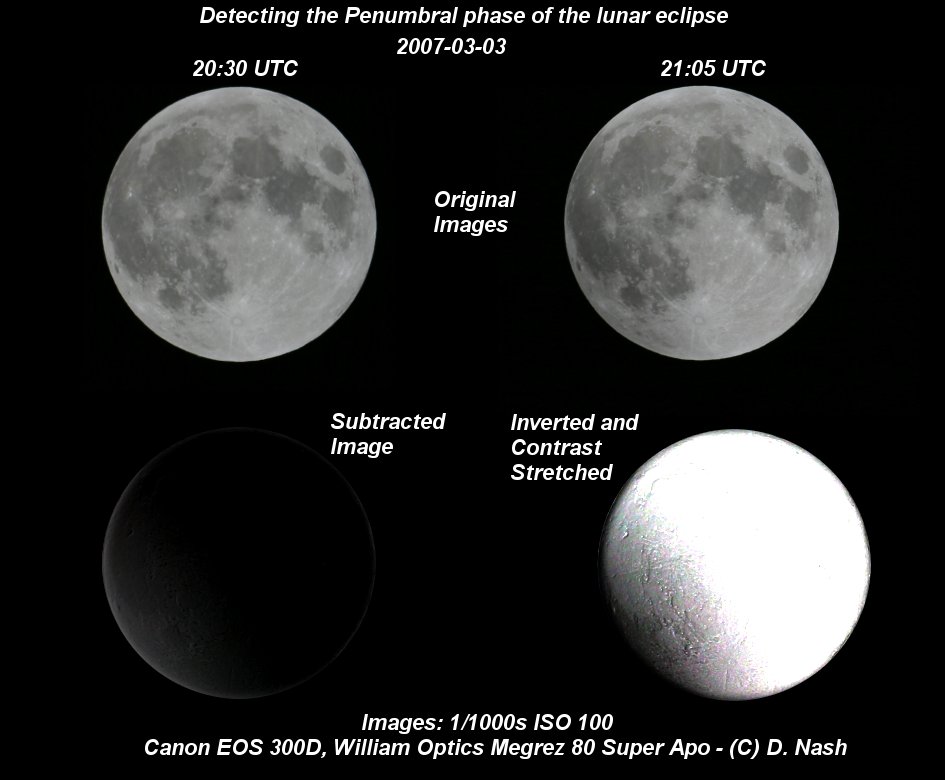
|
During a lunar eclipse the shadowed part is not completely dark, as this composite shows. The light from the sun is refracted around the Earth by the atmosphere so some does reach the moon. However due to the scattering of blue light in the atmosphere, most of the light that reaches the moon in this way is red - leading to a red moon. The setting sun looks red for the same reason.
These images were deliberately exposed to pick up the redness - which means the part of the moon not in shadow is overexposed. The central image was exposed for 2 seconds, while the images each side were 1 second each.
Notice the curved edge of the earth's shadow in the "before" and "after" images, which were taken about an hour each side of mid-eclipse.
|
| to top |
home |
|
Eclipse Sequence

|
This image shows the whole sequence of the eclipse. Clip the picture to see it full-sized. During totality the moon is shown dark, in comparison with the partial phases leading up to totality, then red, as seen with the eye or longer exposure photos. The images in this sequence were photographed with an ISO setting of 100, with most having 1/1000s exposure times but increased to 1/640, 1/500, and 1/320 in the three images each side of totality. The red images were exposures of 1 and 2 seconds.
See below for an animation of the eclipse. |
|
| to top |
home |
|
Eclipse Animation

|
Click the picture to see an animation of the whole lunar eclipse. |
|
| to top |
home |
|
Totality

|
Click the picture to see an image of the mid eclipse. This picture was exposed for 15 seconds in order to pick up the full redness of the moon during totality. Some stars are also visible around the edge.
Click HERE to see a large image, suitable for use as desktop wallpaper.
|
|
| to top |
home |
|
The Penumbral Eclipse

|
Click the image to see it full-sized |
|
The penumbra is the outer part of the Earth's shadow. During an eclipse the moon passes through this part before and after passing through the darker "umbra" central shadow. It is not normally possible to see the resulting darkening with the eye, but a camera can pick it up and show it, especially if digital processing techniques are used to enhance the image. Such techniques were described in Sky And Telescope magazine in the March 2007 issue, and I tried the technique. The article can be read at http://skytonight.com/skytel/beyondthepage/Digital_Imagery_for_Detecting_Earths_Penumbra.html.
The top images were taken at the beginning and middle of the penumbral phase of the eclipse. There is virtually no difference between them, although a slight darkening can be perceived on the left side of the 21:05 image.
The left image below shows the result of subtracting the later image from the earlier one to isolate the difference between them -- the difference resulting from the penumbral shadow on the moon. The bottom-right image is the same image inverted and contrast-stretched to show the shadow clearly. The result shows the penumbra 47 minutes after first contact and is broadly similar to the Sky and Telescope image showing 50 minutes after first contact.
|
| to top |
home |
|
 |
|
All text and images copyright and may not be used without permission
|
|

